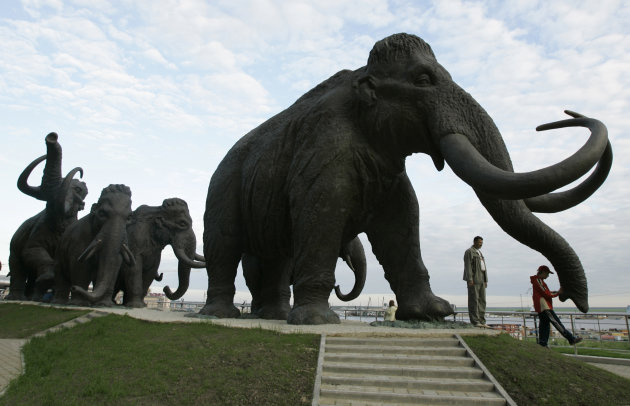Lewis
Member
- Aug 5, 2005
- 15,483
- 621
These fools want to clone a Mammoth. 9/11/12
 Enlarge PhotoAssociated Press/Dmitry Lovetsky,File - FILE - In this June 28, 2008 file photo a sculpture of mammoths is seen in the Siberian town of Khanty-Mansiisk, 2000 kilometers (1250 miles) east of Moscow, Russia.
Enlarge PhotoAssociated Press/Dmitry Lovetsky,File - FILE - In this June 28, 2008 file photo a sculpture of mammoths is seen in the Siberian town of Khanty-Mansiisk, 2000 kilometers (1250 miles) east of Moscow, Russia.
MOSCOW (AP) — Scientists have discovered well-preserved frozen woolly mammoth fragments deep in Siberia that may contain living cells, edging a tad closer to the "Jurassic Park" possibility of cloning a prehistoric animal, the mission's organizer said Tuesday.
Russia's North-Eastern Federal University said an international team of researchers had discovered mammoth hair, soft tissues and bone marrow some 328 feet (100 meters) underground during a summer expedition in the northeastern province of Yakutia.
Expedition chief Semyon Grigoryev said Korean scientists with the team had set a goal of finding living cells in the hope of cloning a mammoth. Scientists have previously found bones and fragments but not living cells.
Grigoryev told the online newspaper Vzglyad it would take months of research to determine whether they have indeed found the cells.
"Only after thorough laboratory research will it be known whether these are living cells or not," he said, adding that would take until the end of the year at the earliest.
Wooly mammoths are thought to have died out around 10,000 years ago, although scientists think small groups of them lived longer in Alaska and on Russia's Wrangel Island off the Siberian coast.
Scientists already have deciphered much of the genetic code of the woolly mammoth from balls of mammoth hair found frozen in the Siberian permafrost. Some believe it's possible to recreate the prehistoric animal if they find living cells in the permafrost.
Those who succeed in recreating an extinct animal could claim a "Jurassic Park prize," the concept of which is being developed by the X Prize Foundation that awarded a 2004 prize for the first private spacecraft.
 Enlarge PhotoAssociated Press/Dmitry Lovetsky,File - FILE - In this June 28, 2008 file photo a sculpture of mammoths is seen in the Siberian town of Khanty-Mansiisk, 2000 kilometers (1250 miles) east of Moscow, Russia.
Enlarge PhotoAssociated Press/Dmitry Lovetsky,File - FILE - In this June 28, 2008 file photo a sculpture of mammoths is seen in the Siberian town of Khanty-Mansiisk, 2000 kilometers (1250 miles) east of Moscow, Russia.MOSCOW (AP) — Scientists have discovered well-preserved frozen woolly mammoth fragments deep in Siberia that may contain living cells, edging a tad closer to the "Jurassic Park" possibility of cloning a prehistoric animal, the mission's organizer said Tuesday.
Russia's North-Eastern Federal University said an international team of researchers had discovered mammoth hair, soft tissues and bone marrow some 328 feet (100 meters) underground during a summer expedition in the northeastern province of Yakutia.
Expedition chief Semyon Grigoryev said Korean scientists with the team had set a goal of finding living cells in the hope of cloning a mammoth. Scientists have previously found bones and fragments but not living cells.
Grigoryev told the online newspaper Vzglyad it would take months of research to determine whether they have indeed found the cells.
"Only after thorough laboratory research will it be known whether these are living cells or not," he said, adding that would take until the end of the year at the earliest.
Wooly mammoths are thought to have died out around 10,000 years ago, although scientists think small groups of them lived longer in Alaska and on Russia's Wrangel Island off the Siberian coast.
Scientists already have deciphered much of the genetic code of the woolly mammoth from balls of mammoth hair found frozen in the Siberian permafrost. Some believe it's possible to recreate the prehistoric animal if they find living cells in the permafrost.
Those who succeed in recreating an extinct animal could claim a "Jurassic Park prize," the concept of which is being developed by the X Prize Foundation that awarded a 2004 prize for the first private spacecraft.






